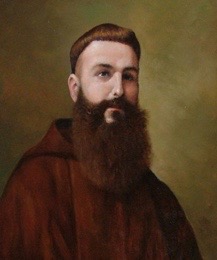Capuchin martyr (1985-1936)
 José Maria Garrigues Hernandez was born in Carcagente (Valencia) into the hearth of a Christian family on 12 February 1895. He was baptised the same day in the parish of Our Lady of the Assumption in Carcagente. He received Confirmation on 22 July 1912 from Mons. Atanasio Soler Royo, duly authorised by the archbishop of the diocese. Juan Bautita Garrigues and María Ana Hernández had eight children, three of whom became Capuchins like Germán.
José Maria Garrigues Hernandez was born in Carcagente (Valencia) into the hearth of a Christian family on 12 February 1895. He was baptised the same day in the parish of Our Lady of the Assumption in Carcagente. He received Confirmation on 22 July 1912 from Mons. Atanasio Soler Royo, duly authorised by the archbishop of the diocese. Juan Bautita Garrigues and María Ana Hernández had eight children, three of whom became Capuchins like Germán.
He completed his first studies in the Capuchin Seraphic Seminary at Monforte del Cid. He entered the Capuchin Order, receiving the habit on 13 August 1911. He made temporary profession on 11 August 1912 and perpetual vows on 18 December 1917. Mons. Ramón Plaza ordained him priest at Orihuela on 9 February 1919. The superiors assigned him to formation and teaching and at the same time he worked in the apostolate. Fr. Domingo Garrigues, Capuchin, says that “he performed the tasks of vice novice master and teacher in a primary school in Alcira. He dedicated himself especially to the apostolate of the confessional, of the infirm and also of the catechesis of children at school.”
Many of those who knew him spoke of him as a religious faithful to his vocation, fervent in prayer and very charitable. “Among the faithful,” says his sister Mercedes Garrigues, “and among his brothers in the Order, he was known for his good life, his jovial character, his charity and his candour.” They were accustomed to say, “He is an angel.” From the same religious it was heard said that he was a very observant religious regarding the Franciscan Rule and Capuchin Constitutions. His brother, Francisco Pascual Garrigues, affirms, “His more remarkable qualities were his profound piety and the attraction he had over the young. No real defect can be identified in him.” A resident in Carcagente, Enrique Albelda, remembers that “his temperament was one of simple and jovial ways. I must also underline his noteworthy quality of charity, quick to give alms. He was a virtuous man, standing out for his limitless patience. He was calm. Humble, judicious and modest.”
When religious persecution broke out in Spain, like his brothers he tried to take refuge in the family home, leading a life dedicated to prayer. The militia took him on 19 August 1936 and led him to the Communist Party Centre. From there at night he was taken to the iron railway bridge over the river Júcar, where he was killed. “If God wants me to be a martyr,” he had said during his period of hiding, “he will give me the strength to undergo martyrdom.” When he arrived at the place of his martyrdom, affirms Clement Albelda, Br. Germán kissed the hands of his murderers and forgave them. He then knelt down.” His body was buried in the cemetery of Carcagente. On 15 December 1940 his remains were identified and transferred to the new cemetery of Carcagente. Now his remains rest in the chapel of the Capuchin Martyrs in the friary of Saint Mary Magdalene in Massamagrell.
Translation based on http://www.santiebeati.it/dettaglio/93149 (06 July 2009)
